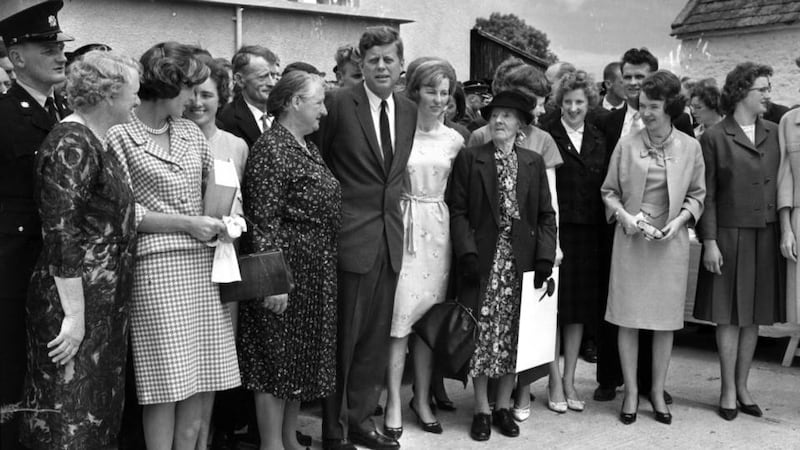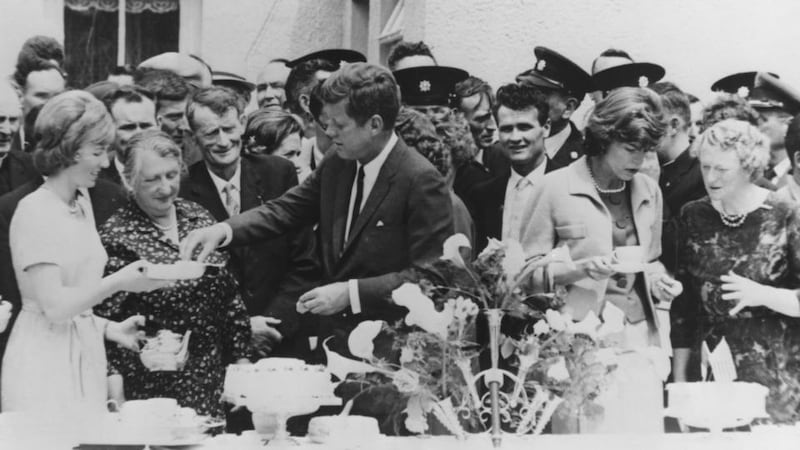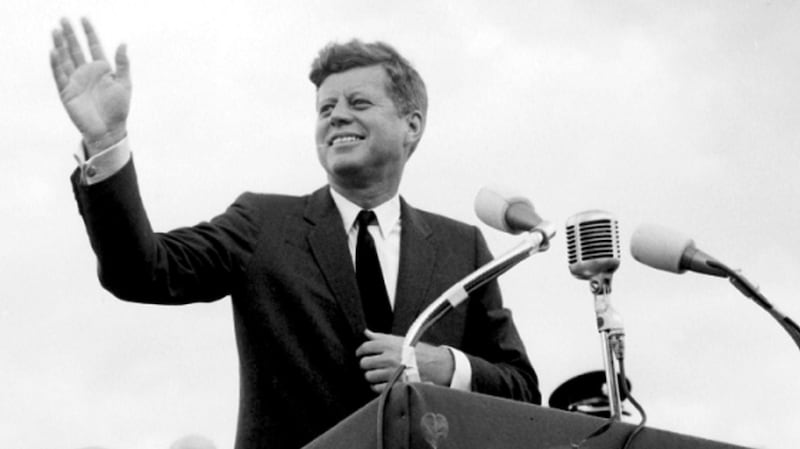Innocence died for Maria Dempsey as it did for so many people around the world when US president John F Kennedy was assassinated in Dallas on November 22nd, 1963.
She was five then, but the memories of president Kennedy’s visit to Dunganstown, Co Wexford would be, as an American commentator at the time accurately put it, a topic of conversation around the firesides for generations to come.
In June 1963, she was lined up alongside other children from the local national school to provide a guard of honour for the president on departing the old farmstead from where his great-grandfather left during the Great Famine.

It seemed surreal that the most powerful man in the world, the personification of Camelot with his beautiful wife, Jackie, and of the hope and optimism of the early 1960s, would drop down from the sky in a presidential helicopter and visit their humble parish. In the 1960s Irish people didn’t have an expectation of such things.
READ MORE
Kennedy was a timeless icon, Dempsey says, looking at photographs of him in his tailored suits with perfectly coiffured hair. He would still turn heads today, and the thing she remembers most, she says, was “the tan and the white teeth”.
“He was just the last word. We were talking about him afterwards for months. Everyone was just blown away. It was like a comet coming into a little place like this. That’s all I could describe. Everyone was mad over this visit, especially my parents. It was something else. This was an incredible day.
“When he left everything was president Kennedy. ‘Eat the brown bread because president Kennedy ate it.’ ‘President Kennedy loves eggs,’ so we had to eat eggs and so on.”
It was like the magic was gone. He was here and he was fabulous and then he was gone
— Maria Dempsey
She remembers her mother and father crying when they heard the news from Dallas. They didn’t have a television at the time. Most Irish households didn’t so they went down to her grandparents’ house to watch the drama unfold.
Her young brain couldn’t process the juxtaposition between the happy homecoming, the tea party, the friendly neighbours and the children with the violence of what occurred in Dallas. “It was so innocent down here drinking tea and then this awful brutality of what happened in America. It was like the magic was gone. He was here and he was fabulous and then he was gone.”
Ida Lennon was 10 and also a pupil of Ballykelly National School. She had lost her father in February of that year and president Kennedy’s impending visit was a “good distraction” from the grief of her father’s death. She remembers on the day Kennedy died that locals went immediately to the nearest church to pray. A photograph, which subsequently appeared in Life magazine, showed a farmer wearing wellington boots kneeling down. He must have come straight from the fields to the church.
Pat Kirwan was a 20-year-old garda not long out of Templemore. He was also a cousin of the president through his mother and was given special permission to be present in Dunganstown.

It was his aunt Mary Ryan, president Kennedy’s second cousin, who hosted the presidential gathering in the yard of the old Kennedy homestead in Dunganstown. It had been concreted over for the occasion at a time when gravel and stones was the norm. He recalls a red phone that was guarded by a member of the Secret Service beside the cow house. “‘Don’t you touch that,’ he told me, ‘that’s a direct line to the White House.’”
When president Kennedy was assassinated four months later, Kirwan was stationed in Bandon, Co Cork. There was no way of phoning home to find out how is family was doing. He was left to process the shock on his own. The years have taken their toll. Of those present for a family gathering photograph at Dunganstown, he is the last male alive.
Mary Ryan was Patrick Grennan’s grandmother. He still lives in the house that Kennedy visited. It’s a private residence, but a reproduction of a 1960s-era sittingroom has been established in an old cow shed.
Because they were ghettoised, they couldn’t forget they were Irish even though they had been living in America for generations
— Patrick Grennan
He also runs the visitor centre that was opened for the 50th anniversary of the presidential visit in 2013. Behind glass cases there are the rosary beads that Kennedy had in his pocket the day he was shot and the dog tag he was wearing. They were given to Mary Ryan by Jackie Kennedy after the funeral.
The centre had a reception to mark the 60th anniversary of Kennedy’s visit during the summer, but it does not intend to mark the anniversary of his assassination. The tradition within the Kennedy family is to mark the happy anniversaries and not the sad ones. It is hardly a surprise given the multiple tragedies that have befallen the family over the decades.
There were four generations from when Patrick Kennedy left Ireland in 1848 to president Kennedy. A further three generations on and the family connection to Ireland remains strong.
All eight of president Kennedy’s great-grandparents were Irish and all their four families entered Boston politics. “Because they were ghettoised, they couldn’t forget they were Irish even though they had been living in America for generations,” Grennan explains.
President Kennedy’s late sister Jean Kennedy-Smith, who was US ambassador to Ireland between 1993 and 1998, was a regular visitor to the visitor centre and a forthright character, according to Grennan. “She was quick witted, but so normal.”
Her granddaughter Stephanie Hood has carried on the tradition and also opened an exhibition in the emigration museum, EPIC. Kennedys still come to Ireland, many to do a term in an Irish university, and visit Dunganstown. The Schlossbergs, Caroline’s children and president Kennedy’s grandchildren, have visited.
Robert F Kennedy Jr, the bete noire of the current generation, who has announced he will stand for the US presidency in 2024, has also been to Dunganstown. He’s a more reasonable man than he’s often painted in the media, says Grennan, despite the fact that Robert has split the family over his many controversial views – not least on the issue of the Covid-19 vaccines.

In the visitor centre there are many echoes of what might have been. Among them is a copy of Kennedy’s undelivered speech in Dallas. It finishes with the refrain, first stated in his inaugural address, that his current generation were – “by destiny rather than choice – the watchmen on the walls of world freedom”.
“We ask, therefore, that we may be worthy of our power and responsibility, that we may exercise our strength with wisdom and restraint, and that we may achieve in our time and for all time the ancient vision of ‘peace on earth, good will toward men’.”













